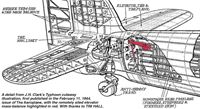Фотографии
-
The Hawker testpilot team in 1939. From left to right: chief test pilot Philip Lucas; John Grierson, production test pilot; Kenneth Seth-Smith, production and later experimental test pilot; Australian Dick Reynell, experimental test pilot, who was killed in action while flying a Hurricane with No 43 Sqn in September 1940.
Самолёты на фотографии: Hawker Hurricane - Великобритания - 1935
-
Регистрационный номер: R7579 The fourth production Typhoon, Mk IA R7579, shows its characteristically muscular Hawker design during an early test flight.
Самолёты на фотографии: Hawker Typhoon - Великобритания - 1940
-
The rear section of a Typhoon fuselage undergoing testing at RAE Farnborough. The rear fuselage was initially beefed-up with Mod 256, the fitting of an external steel band around the transport joint; the introduction of Mod 286 (fishplates and internal stiffening) was reckoned to increase the joint strength by another 20 per cent.
Самолёты на фотографии: Hawker Typhoon - Великобритания - 1940
-
Регистрационный номер: R7646 The Mk IB differed from the IA in being fitted with four Hispano 20mm cannon in place of the latter’s six 0-303in machine-guns. This example, R7646, went on to serve with No 56 Sqn.
Самолёты на фотографии: Hawker Typhoon - Великобритания - 1940
-
Регистрационный номер: DN510 The wreckage of DN510 at Meavy, on the south-west edge of Dartmoor in Devon, after its tailplane failed on February 4, 1943; the only instance of such an accident in which the pilot lived to tell the tale. Note the static balance lever still attached to the bracket on the bulkhead in the photograph at right. In some of the earlier tailplane failures the lever had sheared off from the bracket altogether
Самолёты на фотографии: Hawker Typhoon - Великобритания - 1940
-
Регистрационный номер: EK186 With the distinctive fishplates added at the transport joint as per Mod 286 clearly visible immediately aft of the serial, the wreckage of EK186 awaits further inspection after having broken up in mid-air near Redhill on May 4, 1943. The cause of these failures continued to mystify the investigation teams at Hawker and the RAE.
Самолёты на фотографии: Hawker Typhoon - Великобритания - 1940
-
Регистрационный номер: R7692 Part of the wreckage of Typhoon IB R7692, in which the author’s father was killed while performing a relatively simple test-flight from Langley on August 11, 1942. Exactly a week later another Typhoon IB, R7644, was lost under similar circumstances.
Самолёты на фотографии: Hawker Typhoon - Великобритания - 1940
-
A Typhoon model in the high-speed windtunnel at RAE Farnborough. The tunnel was opened in November 1942 and was designed to test scale-models of up to 6ft (1-8m)-span at windspeeds up to 600 m.p.h. (965km/h).
Самолёты на фотографии: Hawker Typhoon - Великобритания - 1940
-
One of the meticulously hand-drawn illustrations from the official accident report into the crash of R7692, showing the points of structural failure in the rear fuselage. The bottom handwritten caption states that the “tail unit parted from fuselage by failure of the skin mainly at the transport joint between frame K and the butt strap”.
Самолёты на фотографии: Hawker Typhoon - Великобритания - 1940
-
A detail from J.H.Clark's Typhoon cutaway illustration, first published in the February 11, 1944, issue of The Aeroplane, with the remotely sited elevator mass-balance highlighted in red.
Самолёты на фотографии: Hawker Typhoon - Великобритания - 1940
-
A contemporary schematic showing the circuit-test details for the elevator’s mass-balance system.
Самолёты на фотографии: Hawker Typhoon - Великобритания - 1940
Статьи
- -
- B.Livingstone - The Longest Hop (1)
- E.Wild - Don't spare the horses!
- J.-C.Carbonel - Messieurs Papin et Rouilly's Astonishing Whirling Leaf
- J.Moralez - From Nile Eagle to Nasser's Folly
- K.Hayward - Concorde: Independence Day. The political perspective
- L.Andersson - Smooth Operator
- M.Oakey - Richard T.Riding 1942-2019
- M.Wickstead - Rogues' Gallery
- P.Davidson - Off the Beaten Track...
- P.Jarrett - Lost & Found
- R.Riding - Richard Riding's "Battle of Britain" photo gallery
- R.Seth-Smith - Bad Vibrations
- S.Rivas - South of the Border
- T.Buttler - The Oldest Swinger










